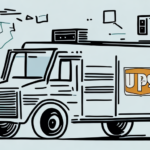Understanding the UPS Emergency Situation Surcharge
As a business owner or manager, keeping up with the evolving world of shipping is essential. One phrase that you may have heard lately is “UPS Emergency Situation Surcharge.” But what does this mean, and how does it impact your business? In this comprehensive article, we will explore all you need to know about this surcharge, including what it is, how it affects shipping costs, and when it is applied. We will also examine reasons for its implementation, the impact of COVID-19, and compare it with other shipping companies. Additionally, we will provide strategies for minimizing its effects on your business, negotiating with UPS, and communicating transparently with customers.
What is the UPS Emergency Situation Surcharge?
The UPS Emergency Situation Surcharge is a fee that UPS charges to recipients of shipments during emergency situations involving high volumes of packages or extreme conditions—for example, natural disasters or pandemics. It is intended to apply only temporarily until operations normalize, reflecting the increased costs and significant operational challenges associated with these situations. The charge is not a fixed rate and can vary depending on the destination, the type of service used, or packages shipped per day. This additional fee allows UPS to cover extra costs associated with transportation, facility, and operational disruptions caused by emergency situations that can disrupt its ability to provide normal service levels.
It is important to note that the UPS Emergency Situation Surcharge is not unique to UPS and is a common practice among other shipping carriers. The surcharge ensures that carriers can continue to provide essential services during times of crisis and maintain their operations. UPS has stated that the surcharge is a necessary measure to ensure they can continue to provide reliable and efficient service to their customers during emergencies. Customers should be aware of the surcharge and factor it into their shipping costs during times of crisis.
Impact on Shipping Costs
How the Surcharge Affects Shipping Costs
If your business ships with UPS, the emergency situation surcharge can significantly impact your shipping costs. This surcharge could increase the cost of shipping a package by as much as 30%. For example, a $10 shipment before the surcharge could now cost up to $13. The surcharge is applicable to all customers and businesses within regions experiencing emergency situations. Thus, irrespective of the number of packages sent or the frequency of use, every customer would incur the emergency situation surcharge.
The surcharge is only applicable during times of crisis, such as natural disasters or pandemics. UPS determines the affected regions based on the severity and impact of the emergency situation. The surcharge helps UPS cover additional costs associated with operating in these regions, such as increased safety measures and transportation expenses. While the surcharge may be inconvenient for businesses, it is a necessary measure to ensure the safety and timely delivery of packages during emergencies.
When is the UPS Emergency Situation Surcharge Applied?
UPS applies the Emergency Situation Surcharge when there is a significant disruption in the supply chain. These disruptions could occur from external circumstances like pandemics, environmental disasters, winter weather conditions, and other unexpected events that prevent normal business operations. For instance, during the COVID-19 pandemic, UPS implemented the surcharge due to a considerable increase in mail order activity, which led to a surge in packages shipped per day, challenging their logistical operations and increasing costs. UPS announced that it would continue to apply the surcharge as long as pandemic-related disruptions persist.
The Emergency Situation Surcharge is not a fixed fee and can vary depending on the level of disruption in the supply chain. UPS determines the surcharge based on the level of demand and the available capacity to meet that demand. Additionally, the surcharge is applied to specific services and destinations, and not all shipments are subject to the surcharge. Customers can check the UPS website for the latest information on the surcharge and how it may impact their shipments.
Reasons for Implementing the UPS Emergency Situation Surcharge
The primary reason for implementing the UPS Emergency Situation Surcharge is to help UPS manage increased operational costs resulting from extraordinary events. The funds generated from the surcharge go towards maintaining and supporting operations during these times, including facility work and the utilization of additional transportation resources to manage mail service volume surges. Furthermore, the surcharge aims to regulate the excess shipping of packages during such times, as businesses become cautious of the extra surcharges.
One of the extraordinary events that led to the implementation of the UPS Emergency Situation Surcharge was the COVID-19 pandemic. The pandemic caused a significant increase in online shopping, resulting in a surge in package volume. This surge strained UPS’s resources, leading to increased operational costs. The surcharge helped UPS manage the increased volume and maintain their operations during the pandemic.
Another reason for implementing the UPS Emergency Situation Surcharge is to ensure that UPS can continue to provide reliable service during extraordinary events. By generating additional funds, UPS can invest in their infrastructure and resources to better handle unexpected events. This investment helps UPS maintain their reputation for reliable service, even during challenging times.
Impact of COVID-19 on the UPS Emergency Situation Surcharge
The COVID-19 pandemic significantly impacted UPS’s operations, leading to the implementation of the emergency situation surcharge due to the increased volume of packages. This surge, coupled with the need to keep workers safe through operational modifications like social distancing measures, enhanced product handling, and sanitizing, caused considerable pressure on UPS’s logistical operations and increased operational costs. UPS stated that the surcharge helps offset the costs of additional resources needed to maintain service levels.
As the pandemic situation improves and package volumes return to pre-pandemic levels, UPS has announced plans to adjust the emergency situation surcharge. By [updated date, if available], the surcharge may be gradually phased out or reduced, reflecting the stabilization of operational conditions. Businesses should stay informed through the official UPS channels for the most current information.
Other Emergency Situations Triggering Surcharges in the Shipping Industry
Besides pandemics, other events that could trigger an emergency situation surcharge in the shipping industry include extreme weather events like hurricanes, earthquakes, or flooding. These disruptions can severely impact transportation infrastructure, including roadways, ports, and airports, resulting in increased operational costs and logistical challenges. Companies in the industry use the surcharge as a strategy to cover their incurred costs during these times and maintain service continuity.
Comparing UPS’s Emergency Situation Surcharge with Other Shipping Companies
UPS is not the only shipping company to implement an emergency situation surcharge. FedEx and DHL, the world’s leading shipping companies, also have similar pricing structures during emergencies. FedEx’s emergency surcharge varies from $0.30 to $1.50 per package, depending on the service, destination, and package weight. DHL’s surcharge ranges from $0.30 to $0.45 per kilogram and can be adjusted on a case-by-case basis. While the pricing structures differ, these surcharges are all implemented to cover the additional costs incurred during emergencies like COVID-19.
For more detailed comparisons, refer to industry reports from sources like Statista or IBISWorld.
Strategies to Minimize the Impact of the UPS Emergency Situation Surcharge on Your Business
Businesses can employ several strategies to minimize the impact of the UPS Emergency Situation Surcharge:
- Diversify Shipping Providers: Use a combination of shipping solutions, spreading packages across multiple shipping providers to avoid trigger surcharges.
- Optimize Shipping Volume: Plan ahead to reduce the number of shipments and group shipments to minimize surcharges.
- Negotiate with UPS: Negotiate discounted surcharges with UPS upfront or adopt a transparent pricing model by passing the surcharge explicitly onto customers.
- Implement Shipping Software: Utilize shipping software to automate carrier selection based on cost and service, potentially avoiding higher surcharges.
Negotiating with UPS to Reduce or Waive Emergency Situation Surcharges
Businesses may negotiate with UPS to reduce or waive the emergency situation surcharge. One approach is to contact UPS and explain specific reasons why the surcharge may not apply in their case. For example, a company could articulate why their shipping scenarios do not entail increased operational costs or how diversifying packages across different providers for sensitive shipments is beneficial. Additionally, companies can negotiate discounted surcharges if they maintain a high volume of shipments regularly or anticipate continued demand. Such negotiations should commence early and be established within a service level agreement (SLA) with UPS.
Communicating UPS Emergency Situation Surcharges to Customers Effectively
Effective communication is vital when informing customers about UPS’s emergency situation surcharges. Position the charge transparently, using clear and concise language to explain why the surcharge is being applied and how it affects the final price the customer pays. Communicate before each shipment and ensure that each receipt indicates the additional surcharge as an added cost. Clear communication helps build trust with your customers and informs them of the reasons behind pricing variances.
Adapting to Changing Shipping Costs and Fees
Adaptation is crucial for business survival, including adapting to changing shipping costs and fees. Businesses can:
- Diversify Shipping Solutions: Ensure consistency in pricing by using multiple shipping providers.
- Negotiate Terms: Work with UPS representatives to establish favorable terms regarding surcharges.
- Transparent Pricing Strategies: Pass on surcharges explicitly to customers to maintain profit margins.
- Flexible Pricing Models: Adjust pricing models to account for fluctuations in surcharges creatively.
By implementing these strategies, companies can minimize the impact of emergency situation surcharges and maintain their competitiveness in the shipping industry.
The Future of Emergency Situation Surcharges in the Shipping Industry
As natural disasters and pandemics continue to affect the world, it is likely that more emergency situation surcharges will emerge in the shipping industry. These surcharges are essential for businesses to manage service volume fluctuations during such events and help maintain service continuity without relying heavily on government subsidies. The emergency situation surcharges reflect the pricing dynamics during crises and could influence price fluctuation models for shipping companies and the industry at large.
Businesses must understand their shipping costs thoroughly to optimize their profit margins effectively. Considering emergency situation surcharges, they need to be prepared for unique and often unexpected emergency situations beyond their control. By adhering to the strategies outlined, companies can avoid or minimize the impact of rising emergency situation surcharges and position themselves as agile and adaptable players in the shipping industry.
Conclusion
Understanding the UPS Emergency Situation Surcharge is crucial for businesses that rely on shipping services. By comprehending how the surcharge works, its impact on costs, and the reasons behind its implementation, businesses can better navigate these additional fees. Implementing strategies to minimize the surcharge's effects, negotiating with UPS, and communicating transparently with customers are essential steps in managing shipping expenses effectively. As the shipping industry continues to evolve, staying informed and adaptable will ensure that your business remains resilient in the face of emergencies and fluctuating shipping costs.




















